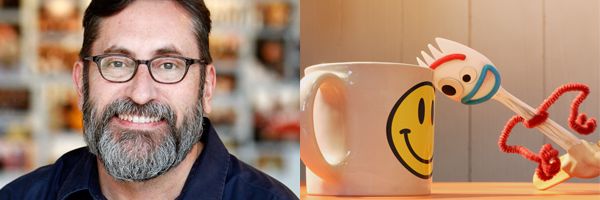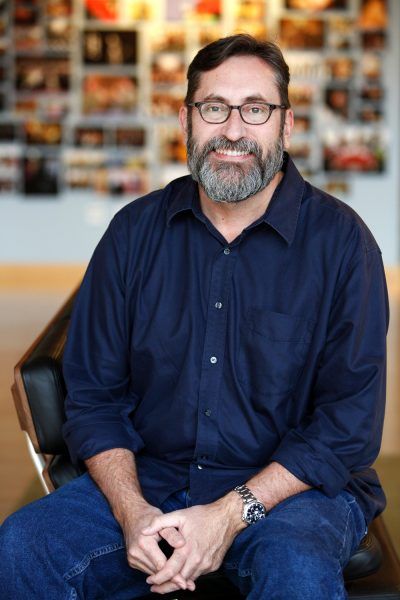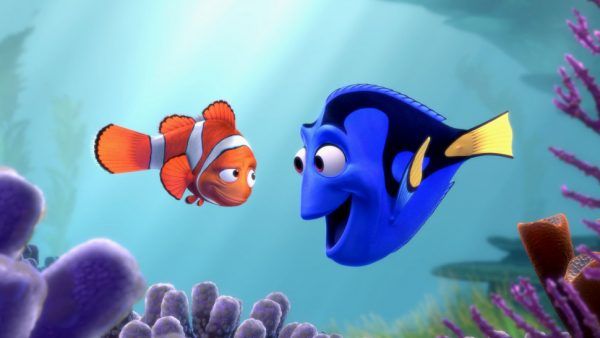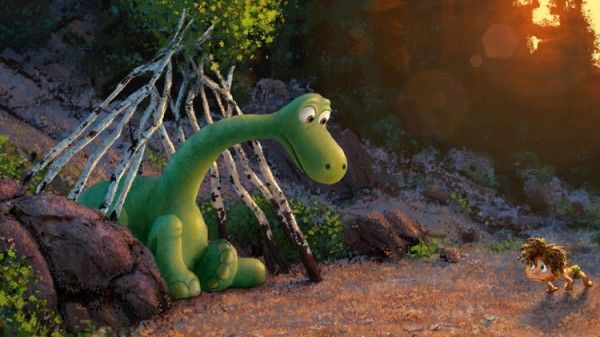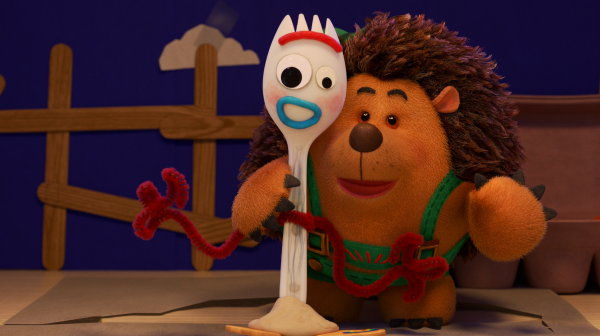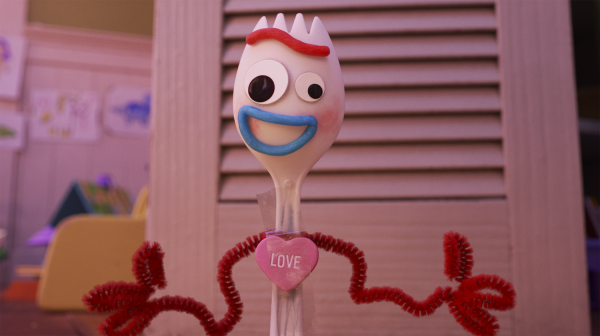Disney’s highly touted direct-to-consumer streaming service Disney+, in the few months since it launched on November 12th, has been a platform of discovery. Subscribers have gone back and re-watched animated classics that they’ve either forgotten about or have been hopelessly locked in the Disney Vault, been exposed to the inner workings of Disney’s most secretive unit with the multi-part documentary The Imagineering Story, and, of course, been turned into puddles of mush thanks to the introduction of a character we’re still exclusively referring to as Baby Yoda in The Mandalorian. But for my money, the greatest discovery has been Forky Asks a Question, a series of short form animated films written and directed by longtime Pixar legend Bob Peterson.
Not only was the oddness of the series audacious and refreshing, but each week offered a different, oftentimes surprising pleasure: as Forky (Tony Hale), the naïve spork character from Toy Story 4, tackles a different earthly conundrum, the animation would take on wildly heightened, sometimes surreal dimensions. Brilliant, hilarious, strange, and oddly touching, each installment of Forky Asks a Question was a bite-size masterpiece. Forky Asks a Question (which concludes today with the tenth entry) is also the latest chapter in Peterson’s astonishing career, which began shortly before the release of the first Toy Story and continues strong today. We were lucky enough to chat with Peterson about his career, what really happened on The Good Dinosaur, and whether or not Forky will ask more questions in the future.
Peterson first joined the studio after he “caught wind” that they were working on the first computer-animated feature film. He knew of the studio thanks to an annual tech conference called SIGGRAPH, where Pixar would display its latest innovations. But when Peterson joined the company, he was relegated to the commercials group (his predecessor had moved on to Toy Story and Peterson was a backfill). Among the commercials Peterson directed at the time: “Magnets” for Hallmark (which wouldn’t be broadcast until after the release of Toy Story) and the “We’ve Got a Taste” ad for Nutrigrain. “I called back to my family in Ohio saying, ‘I’m in California animating flakes and nuts,’ and they said, ‘That’s about right,’” Peterson remembers. “At night I would walk through the halls and see the storyboards and dream about what it would be like to be on this thing,” Peterson said, referring to his goal of working on Toy Story.
When the commercial unit shut down, Peterson realized his dream and started working on the film: he did 70 layout shots, mostly of Scud. “Pete Docter asked me to animate a bit. I actually have an engineering background and I was also a cartoonist in college. But I was more on the technical side. So they gave me Sid, the bad kid next door, because he was very technical,” Peterson said. He has about seven shots in the finished film, including the moment Sid wakes up and says, “I want to ride the pony.” “I was so happy to be a part of it, this brand new form of animation, and it was great to see the team in action, putting the Disney tenets to life but in CG,” Peterson said.
After Toy Story, Peterson became one of the studio’s go-to storyboard artists on Pixar’s initial string of hits: A Bug’s Life, Toy Story 2 and Monsters, Inc. (where he was story supervisor). While pitching commercials, Peterson attracted the attention of Andrew Stanton, the second animator ever hired at Pixar and the eventual director of WALL•E and Finding Nemo (he also co-wrote Toy Story 4). Stanton introduced Peterson to Joe Ranft, who by the time Toy Story was released was already a legendary story artist thanks to his work on Who Framed Roger Rabbit, Beauty and the Beast, The Nightmare Before Christmas and The Lion King. (Ranft died in a tragic car accident during the production of Cars, the first movie he’d ever co-directed. That film is dedicated to him.) “Joe gave me a few tests and I drew some funny things for him. He wanted me to draw something funny for him to make him laugh and I drew myself as a World War II pin-up with my hairy legs,” Peterson recalled. He said Ranft “took me under his wing.” It was Ranft, Peterson said, who: “Taught me the tenets of story for animation, which is different than drawing a cartoon strip. But all those years of pen mileage and pencil mileage helped me step into that role, even though I hadn’t gone to school for it.” You can tell that he still looks back at his time with Ranft as something he still cherishes. “I was so lucky to get involved with that guy,” Peterson said.
By the early 2000s, Peterson was a writer on Finding Nemo, along with director Stanton and David Reynolds, who was coming off of the notorious production of what eventually became known as The Emperor’s New Groove. Finding Nemo would go on to become the highest grossing animated film ever at that time. Stanton knew how strong Peterson was, having watched him pitch commercials and shorts and having seen his storyboard work on the previous films. “He needed a second writer on Finding Nemo, someone to bounce things off of, and off I went writing a good amount of things for Finding Nemo,” Peterson said. According to Peterson, “story structure” is in Stanton’s DNA. “My DNA is more in entertainment than it is in structure. We ended up going well together,” Peterson explained.
The two filmmakers would drive down to L.A. to record some of the voice actors for Finding Nemo and along the way they’d write. “I can remember writing the initiation ceremony for Nemo on the 5 as we’re driving. I remember the ‘ooh-ha-ha’ part came out of a fast food restaurant we had stopped at in Kettleman City,” Peterson said. With so much productivity on the way to Los Angeles, on the way back they’d just listen to Pink Floyd’s The Wall “from beginning to end.” After working on Ratatouille, Peterson got the chance to co-direct Pete Docter’s Up, still one of Pixar’s crown jewels. Peterson loved working as story supervisor on Monsters Inc., got along incredibly well with Docter, and said that Up, which he also co-wrote, was his favorite show of all time. ”Just the fact that we would tackle an old person as a main character I thought had a magic to it,” Peterson said. “Old people have a built in set of stories. They’ve been through wars and famine and happy times and they’ve earned the right to say whatever they want. So it’s this great character waiting to happen. There was an excitement to seeing how we could pull that off.”
After Up, Peterson began pursuing his own directorial feature, The Good Dinosaur. Late in production, Peterson was removed from what would have been his directorial debut. But unlike some other projects that experience a change in leadership, Peterson (unlike Brenda Chapman, Jan Pinkava and Gary Rydstrom before him) chose to remain at the studio. “Pixar was where I’ve always been and where I always wanted to stay,” Peterson said. “It was a no-brainer that I’d stay and work on other things. The thing I learned was I tried to write and direct at the same time. I’d written Finding Nemo and I’d written Up and I attempted to write that one as well.” This is where Peterson said he got tripped up. He then broke down the Good Dinosaur situation in a way that I’d never heard him discuss it before: “Basically, we had a good first act, our second act didn’t progress emotionally like we wanted it and our third act was missing in action. For me it was just a matter of running out of time and Pixar deciding that it wasn’t the story that they wanted to tell. It’s very common to have these leadership changes but my friends are here, the great projects are here, I decided to take it and learn from it and keep going. It was a hard thing to do because I was really invested in it but I felt like it’s a great learning experience and I would continue on and do good work in the future.” If that sounds profound and reflective and inspiring, that’s because it is. The situation with Good Dinosaur clearly still stings but Peterson is too humble and talented to let it derail him for very long – after Good Dinosaur he immediately contributed heavily to Finding Dory and co-wrote the underrated Cars 3.
All of this brings us to Forky Asks a Question, a series of short films wonderfully written and directed by Peterson. It doesn’t feel like a comeback, necessarily, since Peterson has been around and contributing key creative components to almost everything Pixar has produced. But it feels like something of a vindication, that a filmmaker who could have just as easily left the studio he loves, instead chose to stay and wound up with a truly brilliant series that serves as a cornerstone for Disney+, one of the most important initiatives in the company’s history.
“About a year ago we realized we’d like to get a presence on Disney+ and get something going. We’d talked about a lot of things and between not having the resources and not having the idea, we realized we weren’t there yet,” Peterson said. He then seized on the idea of Forky (played by “one of my comedic heroes” Tony Hale) in Toy Story 4, who Peterson described as a “naïve demented plastic object who doesn’t know much but has this wisdom.” He didn’t know much about the film but was drawn to the character in early story reels, zeroing in on the fact that, since he was over his existential crisis in Toy Story 4, Forky could simply be asking what the world is about. “The thing that excited me was featuring him but also being able to feature a whole load of other Toy Story 4 characters. Simplify it down and let character come through and make it as much lunacy as Forky could display,” Peterson said. The production took a year, produced by a very small crew. (Keep in mind that there are two original Pixar movies out this year that will be hitting theaters three months apart.) They could only afford to create 30 minutes of total animation, so Peterson “decided to chop it up into little bits so I could feature more Toy Story 4 characters on the side.” The characters paired with Forky dictated the questions he’d ask – he quizzes Ham (John Ratzenberger) on money, Trixie (Kristen Schaal) about computers and a host of Bonnie’s old toys (played by Carl Reiner, Mel Brooks, Carol Burnett and Betty White) about love. Working with those comedy legends, Peterson admitted, was “one of my career highlights for sure.”
But while Peterson emphasizes the shorts’ simplicity, they really do take some bold aesthetic swings, from the crummy opening title font (“That’s Helvetica, you don’t have to say anything more than that”) and Peterson’s own gruff reading of the title, modeled after his father’s voice (“That has no reason to be there. That hints that this is not going to be your normal series, there’s going to be a little bit of oddness to it”) to moments like in episode 9 (“What is Cheese?”) when Forky and Buttercup (Jeff Garlin) go careening through a vast starfield while various clip art and JPEGs pop up on screen. The last moment of these first bunch of shorts, too, ends on a wonderfully meta moment. (We can’t spoil it here.) Peterson said he was inspired by comic strip artists of the 60s and 70s, the ones that “did some pretty surrealistic things,” and said that the general aesthetic ground rules were established by the character himself. “There is a simple, educational show of the 70s and 80s quality to it that I was ascribing to,” Peterson said. “And it all grows out of Forky. He’s simplistic and somehow complex. He’s a little bit plastic, a little bit throwaway so somehow he fits with that design ethic of dumb question marks flying through frame.”
Disney+ hasn’t said if Forky will return in more shorts (even though there are “a lot” of other questions along with even more Toy Story 4 characters who could visit) and Peterson would only say that he’s working on “something close to my heart” (which made me very happy). But towards the end of the interview, Peterson asked me a question. “Do you want to see more questions answered?” Peterson asked. Of course.

